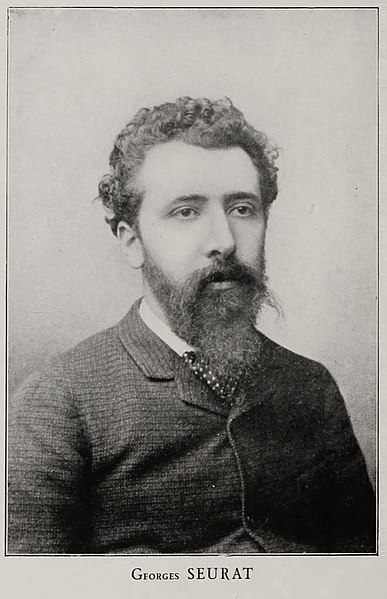
Born: 2 December 1859, Paris
Died: 29 March 1891 (aged 31)
Period: Post-Impressionism, Pointillism
The Life of Georges Seurat
Georges Seurat was a pioneering French painter known for developing the painting technique known as pointillism or divisionism, which employs small, distinct dots of color applied in patterns to form an image. Born in Paris, Seurat displayed a keen interest in art from an early age and went on to study at the École des Beaux-Arts in 1878. He was deeply influenced by color theory and the scientific principles of optics and sought to apply these theories to his art, aiming for a more harmonious and luminous rendering of scenes through precise color juxtapositions.
Seurat’s approach represented a significant departure from the broad brushstrokes and subjective interpretations of impressionism, favoring instead a meticulous and systematic application of color based on scientific principles. This method allowed for a greater vibrancy and clarity of color in the viewer’s eye, a technique he first showcased in his masterpiece, “A Sunday Afternoon on the Island of La Grande Jatte” (1884-1886). This painting, depicting Parisians enjoying leisure time in a park, is a quintessential example of pointillism and remains one of his most celebrated works.
Throughout his career, Seurat was dedicated to refining his technique and theories, producing a relatively small but influential body of work that includes landscapes, seascapes, and studies of urban and suburban life. Despite his methodical approach to painting, Seurat’s works capture the fleeting effects of light and atmosphere, imbuing his scenes with a sense of tranquility and timeless beauty.
Seurat’s contributions were not widely recognized during his lifetime, and he remained relatively isolated from other artistic movements of the time. He co-founded the Société des Artistes Indépendants in 1884 with other artists, including Paul Signac, with whom he shared a close friendship and collaboration. This society aimed to provide an alternative to the traditional Salon and offered a platform for exhibiting avant-garde art.
Tragically, Seurat’s life and career were cut short when he died at the age of 31 from what is believed to have been diphtheria. His innovative techniques and theories, however, left a lasting impact on the art world, influencing not only the Neo-Impressionist movement but also later generations of artists, including the Cubists and Fauvists. Georges Seurat’s legacy is that of a visionary who sought to bridge the gap between art and science, forever changing the course of modern painting.
Georges Seurat’s Notable Works
Georges Seurat, a master of pointillism, left an indelible mark on the art world with his innovative use of color theory and meticulous dot technique. His works are celebrated for their scientific approach to painting and the luminous, vibrant quality of their compositions. Here are ten of Seurat’s most famous and influential works:
- A Sunday Afternoon on the Island of La Grande Jatte (1884-1886) – This monumental work is Seurat’s most famous painting, epitomizing the pointillism technique and depicting Parisians enjoying a leisurely afternoon in a park.
- Bathers at Asnières (1884) – Before fully developing his pointillist technique, Seurat painted this large-scale work, portraying young men relaxing by the Seine River. It’s noted for its careful composition and use of light.
- The Circus (1891) – One of Seurat’s final paintings, this vibrant work captures the dynamic movement and excitement of a circus performance, demonstrating his continued innovation in color and form.
- The Models (1888) – A large painting showing the models from “La Grande Jatte” in Seurat’s studio, providing a fascinating insight into his working process and environment.
- Young Woman Powdering Herself (1888-1890) – This intimate portrait, believed to depict Seurat’s mistress, is notable for its private subject matter and the detailed treatment of the figure against a richly decorated background.
- The Parade of the Circus (1889) – Focusing on the theme of the circus, this painting showcases Seurat’s interest in capturing moments of entertainment and spectacle, marked by his signature pointillist technique.
- The Eiffel Tower (1889) – Seurat’s rendition of the iconic landmark is a study in structure and light, created during the tower’s construction for the 1889 World’s Fair.
- La Chahut (1889-1890) – This painting depicts the cancan dance in a Parisian cabaret, capturing the energy and movement of the scene with vibrant colors and rhythmic patterns.
- Gray Weather, Grande Jatte (1888) – Offering a contrast to the bustling activity of “La Grande Jatte,” this work presents a quieter, more subdued view of the park on an overcast day.
- Le Bec du Hoc, Grandcamp (1885) – A landscape painting that captures the cliffs of Grandcamp in Normandy, showcasing Seurat’s early exploration of the divisionist technique and his ability to render natural scenes with scientific precision.
Georges Seurat’s relatively brief career produced a body of work that profoundly influenced the direction of modern art, demonstrating the power of color and technique to convey depth, light, and emotion. His paintings remain pivotal in the study of Neo-Impressionism and continue to captivate audiences with their beauty and complexity.